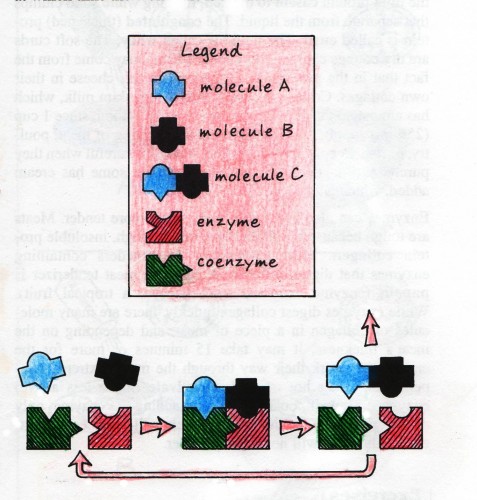 Some enzymes need a helper called a coenzyme. The job of some coenzymes is to help an enzyme do its job, which can be to put together or take apart molecules. Changes in molecules in your body can be called biochemistry.
Some enzymes need a helper called a coenzyme. The job of some coenzymes is to help an enzyme do its job, which can be to put together or take apart molecules. Changes in molecules in your body can be called biochemistry.
The diagram models the bonding of two molecules, A and B.
1. The coenzyme picks up molecule A
2. The enzyme picks up molecule B.
3. The enzyme and the coenzyme fit together, which aligns molecules A and B allowing them to bond forming molecule C. Molecule C separates.
4. The coenzyme and the enzyme separate, and the coenzymes and enzymes are free to pick up more molecules. This cycle is repeated again and again.
Enzymes cause both desired and undesired changes in food. For example, they are responsible for color, flavor, and texture changes as fruits and vegetables ripen. But, they also cause the foods to continue to ripen and eventually rot.
Enzymes can be added to foods to cause changes. Rennin, which is an enzyme taken from the lining of a calf’s stomach, is used in cheese making. When added to milk, rennin causes the milk protein, casein, to combine forming white solid clumps that separates from the liquid. This coagulated (solidified) protein is called curd. The liquid is called whey. The soft curds are dry cottage cheese. This cheese’s name may come from the fact that in the past many farmers made this cheese in their own cottages. Cottage cheese is made from skim milk which has almost no fat. It is a good low fat protein food, since one cup supplies as much protein as a serving of meat, poultry, or fish. People on low fat diets should be careful when they purchase cottage cheese, however, because some has cream added, which adds fat.